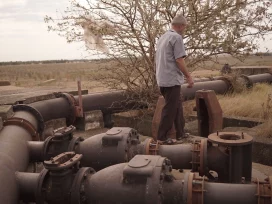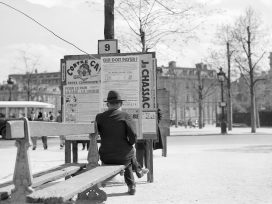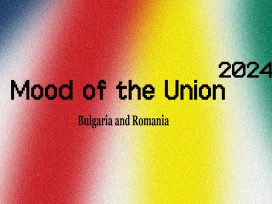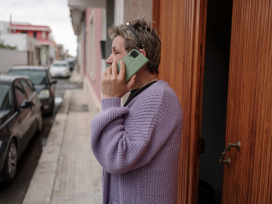For a few years now, the streets of Dumuslău have been paved for the first time in the history of the village. Paved and empty. In the spring of 2022, a little over 25 people were still living in this tiny hamlet in Sălaj County, in northwestern Romania. Pensioners. Most of them alone. Most of them sick. ‘Now that there’s a road, now that it’s easy, who’s going to walk?’
A hunchbacked lady, all skin and bones, with a kerchief on her head and her wrinkled arms wrapped in a jacket, straightens her back in front of the church. Mass started several minutes ago and the yard is full of cars. ‘Who died?’ she asks, with genuine surprise in her voice.
Ever since the village began to slowly die, with each person gone and each house destroyed by time and loneliness, hardly anyone ever goes to church anymore. But at the end of May, the priest who comes over every three weeks invited those he knows to a service like they used to have in the old days, with a full church.
In the 11 years he’s been living in the area, he has buried approximately 30 people in Dumuslău. He has also officiated three golden weddings. His census might be accurate: he visits 17 houses with the Holy Cross on the second day of each new year. ‘The young ones are gone, the old have died, and the village is left desolate.’
A national study carried out in 2021 at the request of the Niciodată Singur (‘Never Alone’) Association shows that one in four urban area inhabitants over 65 feels lonely, and three in ten seniors have no one to socialize with or rely on in case of need. There are no numbers available for rural areas, but loneliness and isolation are an even heavier burden, especially in places where the houses are few and the neighbours live far away from each other.
The calling of the land
I spent three weeks in Dumuslău to discover what old age looks like in the countryside and what the realities are for those left living in small Romanian villages. The themes of old age and ageing have been on my mind for quite some time. I have always seen something candid and priceless in the seniors I interacted with. At the same time, I felt a contrast between their needs and what Romanian society offers them, for the most part. What’s more, in recent years I found myself wishing I still had grandparents living in the country that I could visit.
The Silent Generation and the Baby Boomers – in US-centric academic terms, this is what the people born between 1928 and 1945, and between 1946 and 1964, respectively, are called. The terms explain the reality of those times. The first refers to the fact that an entire generation was sent to battle in World War II, while the second reflects the post-war population boom. For me and my generation, the Millennials, they are our grandparents, those special people who build shrines of your childhood photos and memories of you visiting their homes. ‘When you’re a grandparent you have lots of patience, you give them what you’ve figured out you didn’t give to your children. You are also of a different age…,’ a Dumuslău grandmother told me.
The people of Dumuslău are perhaps the last generation that ‘heard the calling of the land’ in such a visceral way that they stayed put. In a place where the four streets that wind among the trees to form the village remain nameless. Except for one, ‘Pă-daltal’. It’s a name given by the villagers when they were children and went sledging atop the hill. ‘The village had three streets, all of them full. During the holidays, at Christmas, the entire village roared. How they carolled… now it’s deserted,’ says a local woman.
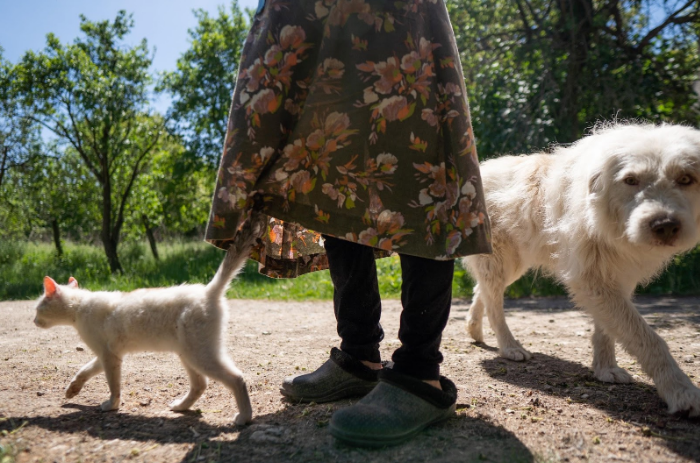
Photo by Patricia Marina Toma.
In the spring, Dumuslău is scented with mălin, as lilac is called here, and apple blossom. ‘When the trees bloom, the whole village smells like perfume.’
During the time I spent in the village, I felt that I was witnessing something unique, on the verge of extinction. Dumuslău is among the last villages in Romania where the life we remember from our grandparents still exists. Perhaps the countryside will remain populated, but the way those who are left here live is very likely to die out with them: even if their houses are fitted with indoor bathrooms, people still carry water from the well, sleep on dowry pillows stuffed with goose feathers, till their gardens even when they can only walk with a cane. What’s more, the Romanian countryside doesn’t just eat organic food, but also fry-ups, all-purpose condiments, and loads of bread. Meals are not that healthy, but spread out and fill the table before the eyes of any visitor. Hospitality runs through people’s veins here.
Declining numbers
One evening, I sit with a lady who’s over 70 years old, in the yard of the house where she lives alone, and we do an informal census of the village. Everyone knows everyone, so she begins her spoken tour of the village and visits each house, one by one. It’s quiet and you can hear all the sounds made by the critters nearby: a hen clucks, a bumblebee hums, the wind rustles among the leaves. At one point, one neighbour comes by for some palinca and another for eggs. The interactions seem natural, but they are among the few I will see during my stay. The village is full of wooden gates left open, onto which spiders have woven their homes.
For some reason, people here have stopped socializing. They tell me about conflicts over a few square inches of land or unfulfilled love stories that took place decades ago. Perhaps the past is still present and that’s what makes people live in their own backyards. ‘People don’t have the culture of humanity,’ a local woman sadly sums up.
‘The biggest shame is that no one comes calling,’ another woman sighs. ‘You don’t have neighbours to come call, they all died, it’s as if a bomb fell on them and they all died at the same time.’ The woman has visited her kids in the city, but she doesn’t feel good there either, because they have to go to work and she’s still left alone. ‘I don’t like it in the city, I grew up in the country. When you’re young, you’re young, not old and sick. When it rains, my whole body aches like this. Veins swollen like frogs and rheumatism,’ she recounts as she gestures with her twisted arms.
Back to our house-to-house census, we come up with 29 people who live here permanently. Half are widowed and live alone, most of them women. Some were born here, ‘others came as daughters-in-law.’ Women live longer than men, a lady in her 70s explains to me. ‘I’m alone, there’s the trouble. And sick. It’s all on me.’ ‘My man died,’ another local widow tells me, describing the worst thing she’s had to live through. In most couples, the wives were 10-12 years younger than the men they married. This age difference became poignant in their old age. ‘A man shrivels up and sags as he gets old,’ another lady in her 80s tells me.
In 1977, Dumuslău had 327 inhabitants. By 1992, the population had halved, and ten years later had dropped to less than 100, the official census shows. In 2022, fewer than 30 people were inscribed in the authorities’ records. Both the inhabitants and the authorities say that the area has been depopulated because of a lack of infrastructure and jobs, two constants in rural life. Before 1989, most villagers worked at cooperative state farms that later closed. In addition, the inhabitants of Dumuslău explained that they didn’t lack their own land, which they were able to work.
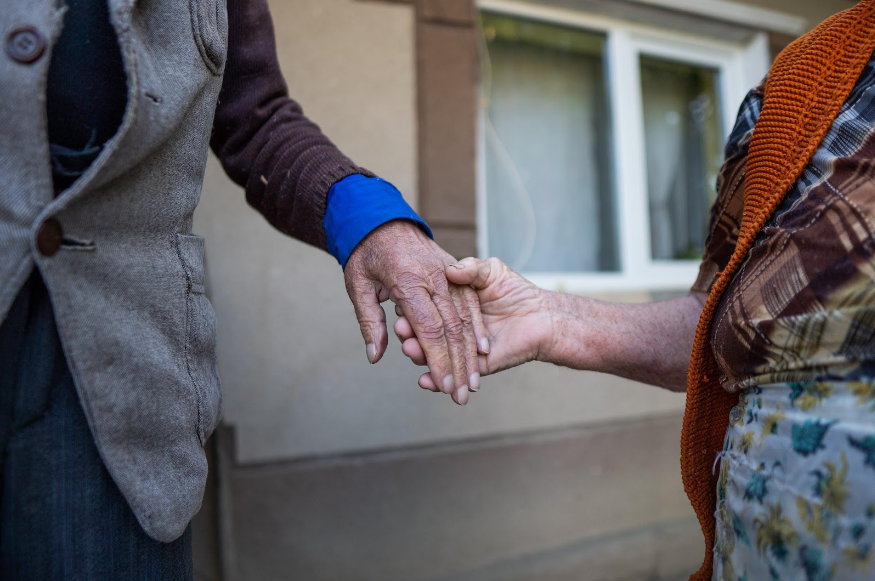
Photo by Patricia Marina Toma.
‘A long time ago’ is the universal answer. When did the school close? When did you last go to town? And to the doctor? When did you retire? When was the last time you were happy?
The school, which closed before 1990, was located in the same yard as the village church. Now, between the walls where the village pensioners once learned the alphabet, post-funeral feasts are held.
Church bells and surveillance cameras
The church is one of the few reasons to get out of the house that people still hold on to. They either go to church or the cemetery; they either visit their dead or tend to their own graves, which they prepare ahead of time. Taking care of their final resting place is a priority.
‘Since my 28-year-old baby died, I’ve also gone bad in the head,’ a lady tells me. All she knows about her son’s death is that he rode away in his cart and then a local man found him dead, ‘head down in the ground.’
The church bells sound the village to life, but they, too, are now heard ever more seldom. A few years ago, when more people lived here, you’d hear the bells every day at noon. They also tolled every time one of them went up above (that’s meant literally, because the cemetery is on a hill at the top of the village). Then the bells were rung three times a day for three days.
Now they toll once every three Sundays, when there’s service at the village church. There’s one bell down in the churchyard and another one in the tower. ‘But who can climb up there to sound it?’
The benches outside the yards, where they exist, are generally empty. A face can be seen in the windows whenever a car passes – rarely. On the weekends, on the other hand, when the children or grandchildren come from the cities where they live – mostly in Zalău, less than an hour away from the village – the street is filled with cars parked at almost every gate.
The distance from the city feels and acts like a boundary. Since the population of the village has dwindled and the few people left here weren’t exactly loyal customers, the local shop is rarely open, and it no longer brings in bread daily. Around a dozen loaves are brought in every week, says the woman who runs the barely profitable business. In the store improvised inside a house, the shelves are almost empty. There are only a few cleaning and hygiene products, a few sweets, corn puffs, pasta, canned goods, beer, and that’s it.
Most people in Dumuslău receive bread from the city, whenever their children or grandchildren visit – and bread is one of the most important foods here. Since relatives from the city come over once a week, people freeze or refrigerate their bread, so that it lasts longer and is as fresh as can be when they eat it. There were refrigerators in every single house I entered and they were always full, like an ornate Christmas tree. It’s a sign that people remain cautious and look to the future.
Surveillance cameras make up for the absence of younger relatives and the powerlessness that comes with age. Children living in the city virtually walk into their parents’ or grandparents’ houses to make sure that they’re safe. They’re threatened by both diseases and potential thieves. Surveillance cameras are also the authorities’ way of protecting the inhabitants of the village, the mayor explains. Several cameras were installed at ‘strategic points’, he says, after a number of robberies took place: copper boilers, pillows and goose-down duvets.
In recent years, the cameras have faithfully recorded life in the village, summed up in the same repetitive shot: empty streets, where the silence is rarely broken by human footfalls.
There are more cameras in the village than doorbells. Likewise, more numerous than the houses in which people live are those in ruins, which nature now inhabits. From the street, it seems that the village is composed of stills taken in different eras; from newly renovated houses with thermal insulation to houses with exposed materials and wells covered by climbing plants. ‘There are places where there used to be houses and now you can’t even see them.’ Demolished. Sold for building materials. Collapsed.
There are also houses whose gates are closed with boulders, but with surveillance cameras mounted somewhere visible. The elders whose homes are monitored follow their relatives’ advice: never touch the cables or the cameras. They look at the devices, essentially unaware that these are faithfully capturing their lives, like silent witnesses on the corner of the house. This distance allows them to live freely in their households, even when this means cutting their toenails out on the porch with a kitchen knife, wielding it with the same dexterity of a toenail clipper.
Digging for survival
Dumuslău is not just surrounded by nature: a good chunk of the village has been swallowed by it. ‘Everyone likes where they come from, so they say. In my youth I couldn’t wait to run off to the city, now I long to come here. Why? I feel freer, we feel better. I’m so sick and tired of that high-rise. Here, we’ve always lacked roads. So we used to walk more. There’s never been a bus in this village. That pushed people away, young people went to the city,’ says a pensioner who often comes to Dumuslău, her native village.
Today, there’s just one horse left in the village. His 78-year-old owner uses him for agricultural work, but also as a means of transport when he leaves the house. Otherwise, he has a daily ritual – he takes the chickens out in the yard for an hour, to have them graze protected from the fox. Then he closes them up and also retires into the house.
Old age has you hunch over, your joints give way, your sight and hearing decline, and every single step means pain. ‘The legs. They hurt more when you sit,’ say several local women who still work their land.
Most of them never go anywhere anymore, only out in the garden, which has become their life’s symbol. ‘We have nowhere to go, we have outfits, elegant clothes, but I can’t wear them out in the garden!’
They miss having ‘more stamina to work’, because work was a big part of their lives. That may be why now the garden is still their most precious possession. It’s where they can still work and feel young. They keep it alive and it does the same for them in return.
‘I don’t have to dig, it’s just that I can’t bear not to,’ said a lady who, like many others, was told by her children to stop working in the garden and take better care of herself.
The weather dictates life here. ‘God, give us a little rain, because it’s hard to dig when the soil is so tough.’
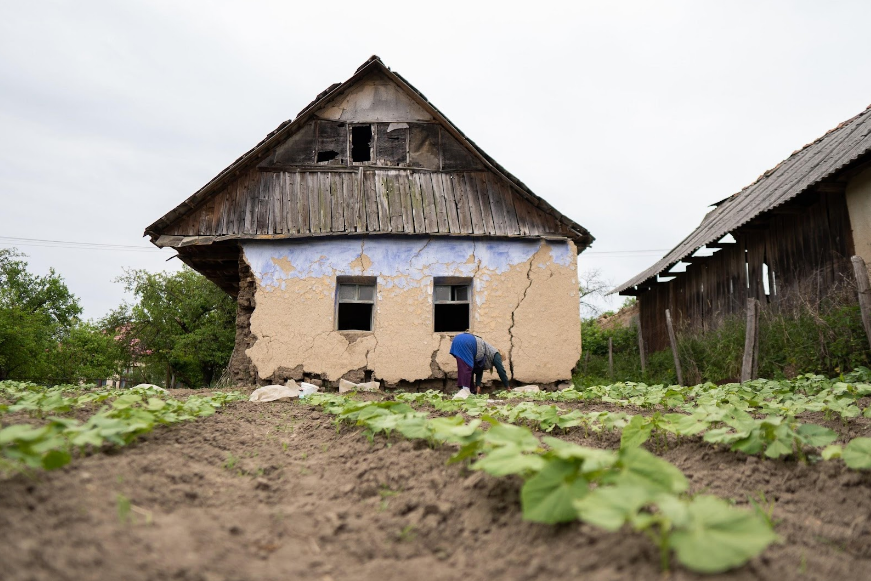
Photo by Patricia Marina Toma.
A lady holds on to the tomato stakes as she waters the fruit. ‘My back hurts so much, my shoulders, it’s like everything is rotting,’ she says while walking among the seedlings. She is wearing a pair of flip-flops and her toes are straddled, as if someone had crammed them into shoes a few sizes smaller. She only wears shoes to church. ‘It’s tough.’ But there is a saying here: ‘Potatoes and hay, the old people used to say, are the foundation of the house.’
Walking canes, improvised out of all types of sticks, are ubiquitous. When they are not helping the elderly, they sit in various corners as witnesses to their existence. ‘My knees have fully turned to flour dust, my bones are grinding, I’ve got no fluid between my bones at all.’
The village midwife has been dead ‘since the beginning of time’. There is a medical dispensary in the area, but it’s 15 km away, in Carastelec, the commune to which the village belongs.
There is no permanent support service: neither the police, nor the drug store, nor the church is open 24/7. At the same time, the discourse of both the authorities and the priest insists on exclusion and isolation – the priest makes racist comments during his church service, and a few years back the police went door-to-door to distribute leaflets urging locals to protect themselves, especially from ‘Rroma’.
For most, the only constant is loneliness. But they seem to have found a – sometimes painful – cure to it: memories.
‘In the fall he shook the plums off the tree and in October he was gone,’ a 77-year-old widow tells me. Her husband died at the age of 79. After more than 60 years they spent together, ‘I will cry for him for as long as I live,’ says the woman sitting on the dresser in her kitchen. In the same setting, she recalls, she received a dowry when she got married: one and a half ‘holds’ of land, more than a square kilometre; four sheep; one heifer; six pillows and a goose feather duvet. Now, they are all carefully preserved memories.
‘I find loneliness the hardest, loneliness kills you,’ the teary-eyed woman explains. Loneliness is partly vanquished with photographs. In each house, a few photos take up the place of honour: the wedding photo, photos of the children and grandchildren, next to icons of the Last Supper. Old-time artefacts mixed with the grandchildren’s toys, like a puzzle of the lives that end and those that continue.
In the eyes of their grandparents, grandchildren are always there. ‘He’s so dear to me, it’s as if he’s real in this one, kiss his little eyes!’ says a proud grandmother who misses her grandson, now an adult and about to get married.
But the sons and daughters, the grandsons and granddaughters, only come to visit. They leave just as sparrows do before winter, and those left here wonder, with tears in their eyes, if they will live to see the next spring.
Healthy legs to walk and dance
Maria (84) is the oldest woman in the village. She got married at 17 and became a widow with two children before the age of 60.‘My knees hurt, it’s as if there’s a man in there pummeling with his axe,’ she says.
‘When I sleep, one of my legs goes numb, then my toes, my hands, they’re all tingly,’ her neighbour adds.
Like many of the villagers, Maria no longer dares keep chickens. One morning, as she was reading from her prayer book, a fox stole her poultry. Back when she was 68, he had 100 fowls . She didn’t even have a guard dog. If she could, she would keep a cow, because she likes milk. Now she drinks powdered milk with cocoa, brought in by her children from the city.
She feels the city is dangerous. She doesn’t even remember the last time she was in Zalău. When one of the grandchildren told her he was going to America, she got scared. ‘If you go out into the world, someone will beat you, kill you.’
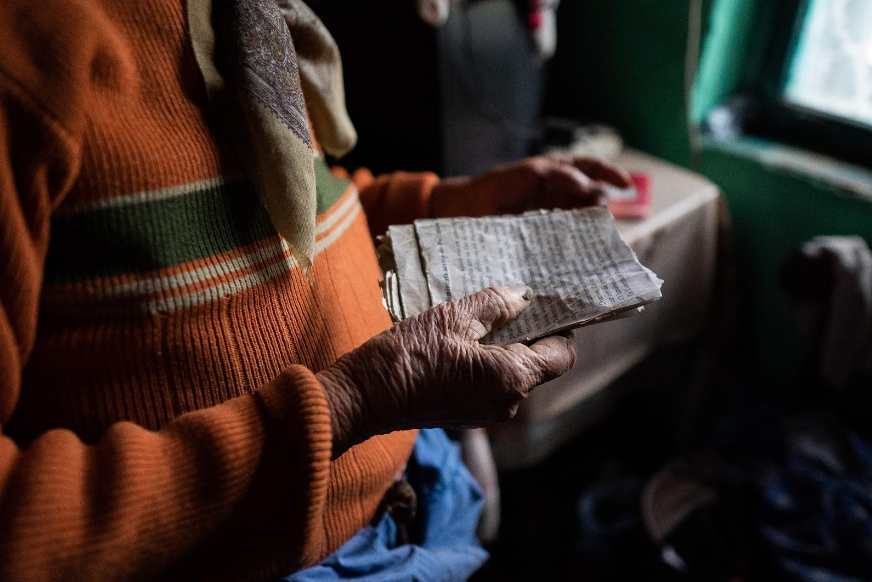
Photo by Patricia Marina Toma.
Her eyesight is too poor to read or watch TV nowadays, so every day she listens to the radio, which sits above the TV. Television is the most accessible medium that allows people to escape the village, the house, their lives.
There’s fresh lilac and medicine on Maria’s table. On a white paper, her daughter has written in large letters the instructions on how to take the pills. When the weather changes, her skin hurts from a cholecystectomy she underwent 20 years ago. Her legs are cramped up all night, she can’t sleep. She goes to bed at 7 p.m. and gets up ‘whenever I’m able to, at 7, at 8.’
‘I go to my garden every day.’ She tends to the garden so that she has a couple of things readily available and does not depend entirely on what the children bring her from the city. That’s why she still tills the land, despite the fact that she can barely walk.
She always wears an apron, as do most of the women here – because that’s tradition, but also because it’s indisputably useful: it’s where you keep the keypad phone (which barely gets any reception, especially in the garden), one of the ways in which one keeps in touch with relatives around here. In their aprons, women also keep the vegetables from the garden and the eggs from the yard that they bring back home.
Looking down at her swollen legs, which have trouble taking her places nowadays, Maria remembers how in her youth she would walk 15 kilometres to Sărmășag, or nearly 30 kilometres to Şimleu. There, she sold eggs, chickens and various items that she wove on her loom.
For the people here, youth also meant healthy legs, capable of carrying them for miles, legs that kept them on the dance floor for hours on end and didn’t hurt every day and night, as they do now. Hip and knee prostheses are a well-known reality to many of the residents of Dumuslău. But the prostheses didn’t rid them of the pain, nor did they restore their mobility. They do, however, keep them up on their feet. Maria wishes she was at least 30 years younger – roughly, my age now.
‘What did I work so hard for?’, she wonders. ‘That was life back then. It was very difficult,’ the woman answers to herself.
Maria’s most treasured memory is from the times she went dancing on Sundays. In most of the homes I visit, this memory is recounted, with various small details differing. Dance parties were traditionally held once a week, at a house in the middle of the village. On Saturdays, the women would prepare some food for the musicians. ‘We danced until the cows came home.’
